Simple But Great: A taste of Hungarian Cuisine

According to GLOBS Magazine, many people, especially Hungarians, consider Hungarian cuisine to be simple. Onions, paprika, a lot of carbohydrate, simple! But, let us be honest! Even the highly praised Italian cuisine does not work with complex flavours and nor can its dishes be considered calorie-free: just think of pizza! It is the fresh ingredients and careful preparation that makes it so good. That applies to good Hungarian cuisine, too!
PÖRKÖLT (STEW)
This real favourite of traditional Great Plain peasant cuisine is a ragout with succulent chunks of meat, cooked in a thick, onion and red paprika sauce. A pörkölt can be made from pork or beef, though mutton and even tripe are also delicious. Its little brother, the ‘paprikás’ is also like a stew but in general is made of lighter meats, such as chicken, lamb or rabbit and takes less time to prepare. The flavour of the pörkölt depends on the meat, browned in fat, then cooked until tender in a little water with the already fried onions, garlic and red paprika, with the addition of marjoram, caraway seeds and red wine to taste. It is best served with fresh-cooked pasta, known as ‘nokedli’. When preparing a paprikás, you do not have to fry the meat, but can enrich the aromatic, fragrant sauce with sour cream.
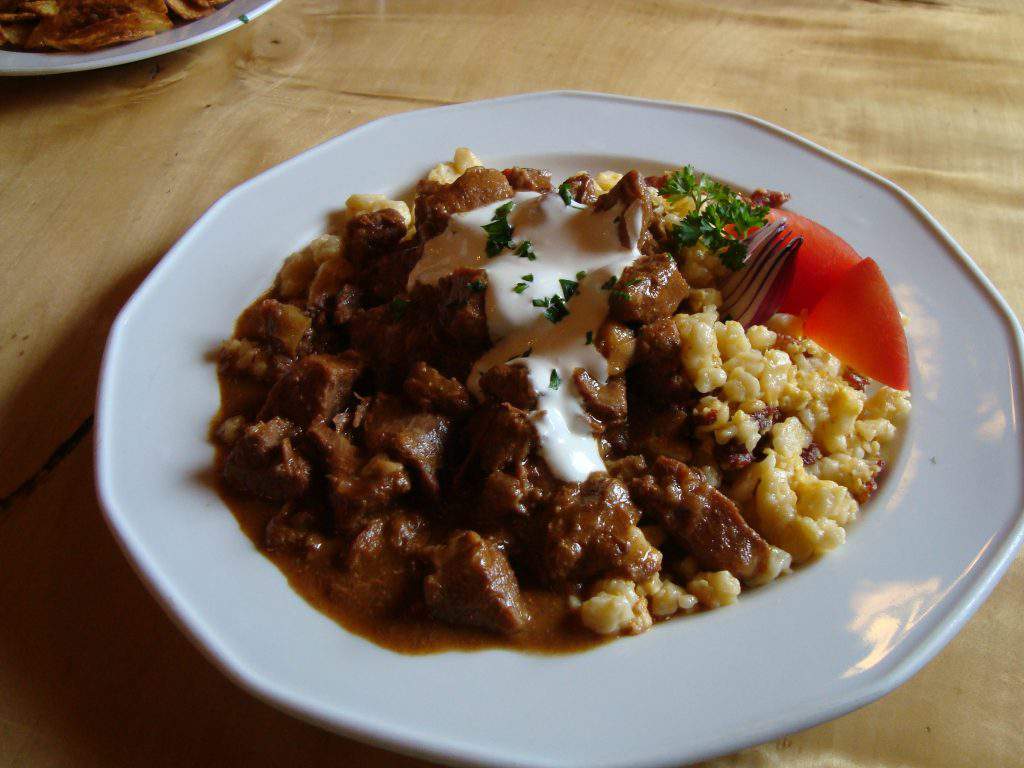
POTATO DOUGHNUT
This popular summer delight for Hungarians is also quite heavy. In the summer, the shores of Lake Balaton and the River Danube are populated by tiny stands making the incredibly popular potato doughnuts in varying quality but large volume. The large, savoury, raised potato doughnuts are deep-fried in oil and served either natural or with an abundant spread of cheese and sour cream or garlic. In recent years more and more ‘potato doughnut monsters’ have also emerged, topped with fried pork knuckle or even stew instead of, or in addition to, the traditional filling.
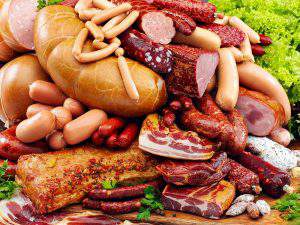
BACON, SAUSAGE AND OTHER PORK DISHES
The home butchering of a pig is a real winter event in Hungary. Traditionally, the carefully raised pig is slaughtered at dawn and then its processing begins. Not one bit of the animal is wasted. The festive occasion is attended by the adults and children of the family and the adults, fortified with regular shots of the ‘fiery’ pálinka, also actively take part in the processing work. They produce fat bacon and hams, preserved with salt and smoke. Another way bacon is prepared is by boiling and then flavouring with garlic and red paprika paste. Hungarians do not waste the blood, either. It is mixed with, marjoram, black pepper, rice or breadcrumbs and, often, meat from the pig’s head, then stuffed into intestine cases and cooked. Hungarian black pudding can be consumed cold but it is really tasty when baked. Sometimes liver or lights are used as filling. It may sound strange, but this ‘pork delicacy’ usually does not contain any paprika, although it is traditional in some villages. The Hungarian sausage, seasoned with paprika, caraway seeds and black pepper and smoked intensively to the Hungarian taste is another great favourite. The pig’s stomach is not wasted either. Brawn is made by filling it with head meat and the cartilaginous parts, seasoned with pepper and paprika. It is first cooked and then smoked.
HUNTER’S MEAT
The Hunter’s Meat was one of the brightest stars of the Austro-Hungarian Monarchy’s everyday cuisine and its popularity is still unbroken. The consumption of game meat was the privilege of the higher social strata, so the preparation of this noble meat is different in character from the Hungarian foods of peasant origin. The strongly flavoured and aromatic game meat is marinated in water with vinegar, salt, onion, peppercorns and bay leaves, for at least one day. Then the meat is cooked with chopped carrots and parsnips. The cooked vegetables must be caramelized with angelic patience until they turn dark brown. Hard work it may be but it is worth it, because that gives the dish its characteristic flavour. The meat is served with bread dumplings and the sauce, which has been enriched with sour cream.
GOULASH SOUP
Goulash soup is a descendent of a real Hungarian herdsmen’s dish, the goulash. Herdsmen cooked the meat of the Hungarian grey cattle raised on the great Hungarian Plain with bacon and paprika, and ate it with bread. Its popularity and its rise to become a national dish dates back to the reign of Joseph II., when the Hungarian nobility, who feared for their national autonomy, took this typical Hungarian dish as a symbol of their national identity. The thick goulash known in foreign countries, which is in fact more like a ‘pörkölt’, came about due to its value as a political gesture at the beginning of the 19th century. For today’s famous everyday goulash soup, the meat chunks are fried with onions and then cooked in water with potatoes, parsnips and carrots.
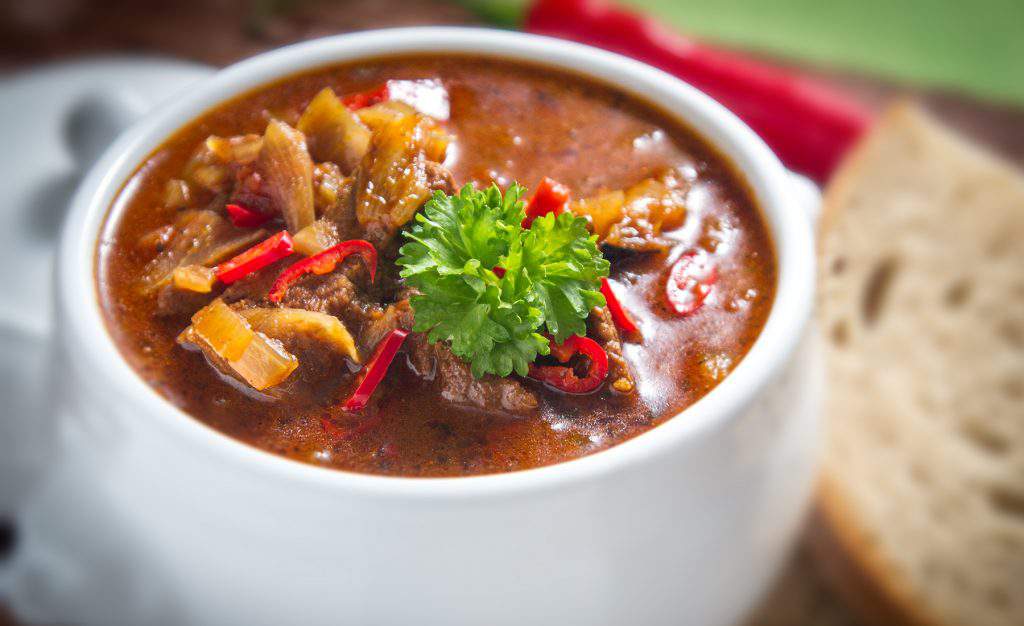
FISH SOUP
There are few Hungarians who, if they eat fish, do not like this thick, often spicy, fish soup full of paprika. The dish of ‘Fishermen’s Style Fish Paprikás’ is contained in a Szeged Cookery Book of 1871, and is practically the same as the dish currently known as fish soup. The fisherman’s style suggests that all the ingredients, i.e., paprika, carp and a large amount of onions are put into the pot simultaneously. This basic recipe is used differently by the populations living next to the rivers Danube and Tisza and by Lake Balaton, and the basic recipe varies almost village by village. Around the town of Baja, pasta is also added to the soup while, in Szeged, this dish is never prepared without concentrating the juice with minced small fish. If you would like to read a great recipe of Fisherman soup, you can get HERE.
Photo: GLOBS MagazineSCHNITZEL
These slices of meat in golden breadcrumbs, named Viennese slice in Hungarian, are the gift of 19th century Viennese cuisine to Hungarian gastronomy. The real Viennese slice is made from tender veal and, in order to be really delicious, it should be fried in a mixture of pork fat and butter. Some experts say that should be done twice in succession to make it really crunchy. In the territory of the former Austro-Hungarian Monarchy, meat slices rolled in breadcrumbs and fried in fat are still prepared. This dish is also a great favourite of the Milanese people. In fact, the current ‘Milanese Schnitzel’ was invented in the northern Italian town in the 16th Century. The Milanese chefs began to roll the meat in breadcrumbs, thus imitating the splendid, actually gilded, courses of the Venetian nobility.
GOOSE LIVER
The pale, succulent, melt in the mouth, liver of a fattened goose, is a magnificent dish requiring no special seasoning. It is most delicious when accompanied with white bread, and a slightly sweet red onion jam. It is aromatic not only when fried slowly in goose fat, but also when cooked slightly in hot water and blanched. However, this delicacy offered in almost all restaurants is controversial. To make a goose grow such a soft, large and fat liver, it needs a lot of nutrients. Since, unlike us, the bird does not eat much more than it needs, it is traditionally force-fed to achieve the desired effect. Animal protection organizations object to that procedure, and opinions vary about its negative effects of on the birds.
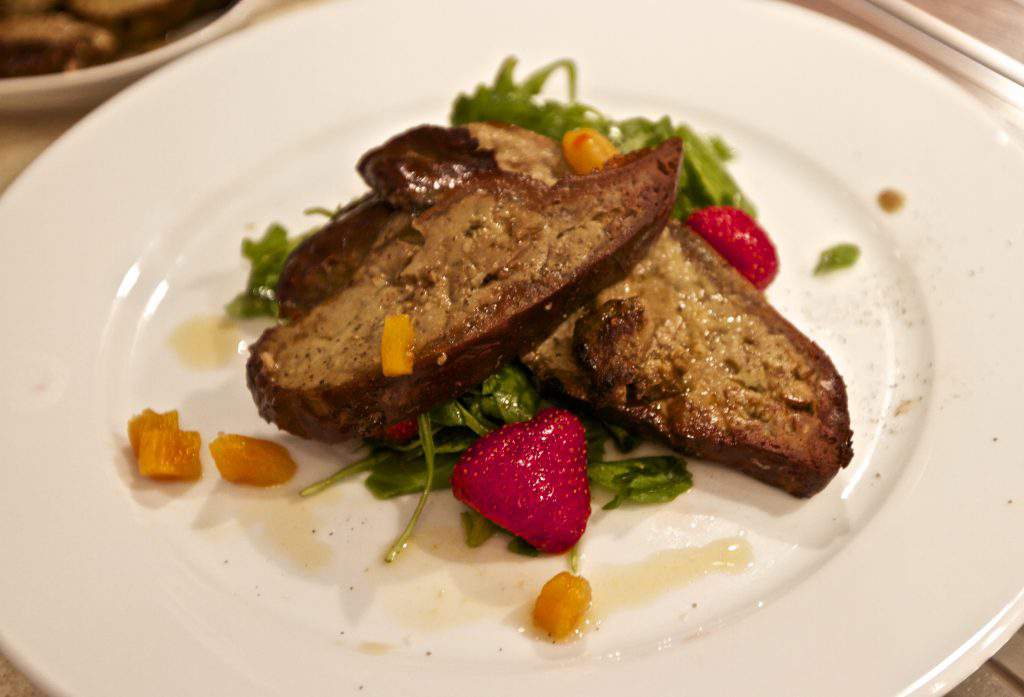
STUFFED CABBAGE
Cabbage and meat have been eaten together by Hungarians for hundreds of years. In the 18th century, according to Mátyás Bél, “Bacon and cabbage is the Hungarian coat of arms”. Nowadays, like most Hungarian dishes, it is prepared with paprika, but the main ingredient is fermented cabbage (sauerkraut). The whole, marinated cabbage leaves are stuffed with a mixture of minced pork, rice, onion and black pepper. The thus created small packages are cooked in a thick ragout made with smoked meat, onions, and finely chopped sour cabbage and served with sour cream.
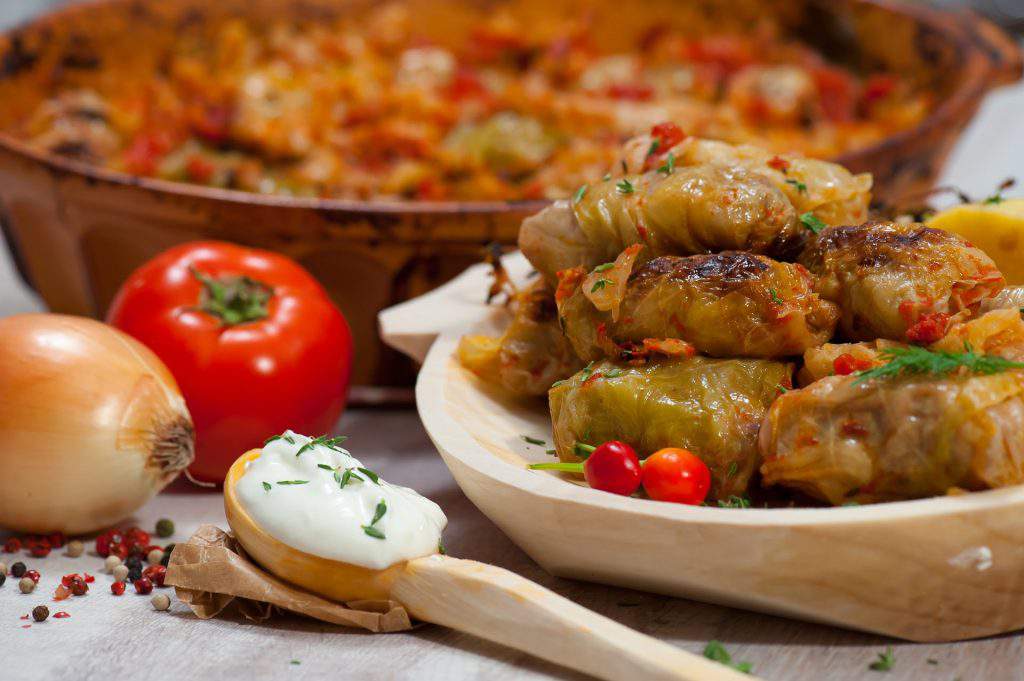
DOBOS CAKE
This cake of five thin sponge and chocolate layers with a golden brown, stiff caramel layer on top, was named after its creator, master confectioner, József Dobos. The cake, created at the end of the 19th century stood out from the fashionable, fancily decorated cakes of its time. The cake was also enjoyed by Emperor Franz Josef and Queen Elizabeth, who sampled it in 1885 at the first National General Expo, in Budapest. Dobos kept the recipe for the cake secret and transported it to Europe’s great cities on carts in a special wooden box covered in ice. Many tried to reproduce the incredibly fashionable cake, but nobody was able to match the original Dobos recipe, which the master published only in 1906, at the same time retiring from business and selling his shop. What could be so special about an ‘ordinary’ chocolate cake? At the time, cakes were decorated with creams either cooked or fresh, but the thick, silky, chocolate buttercream was the innovation of József C. Dobos.
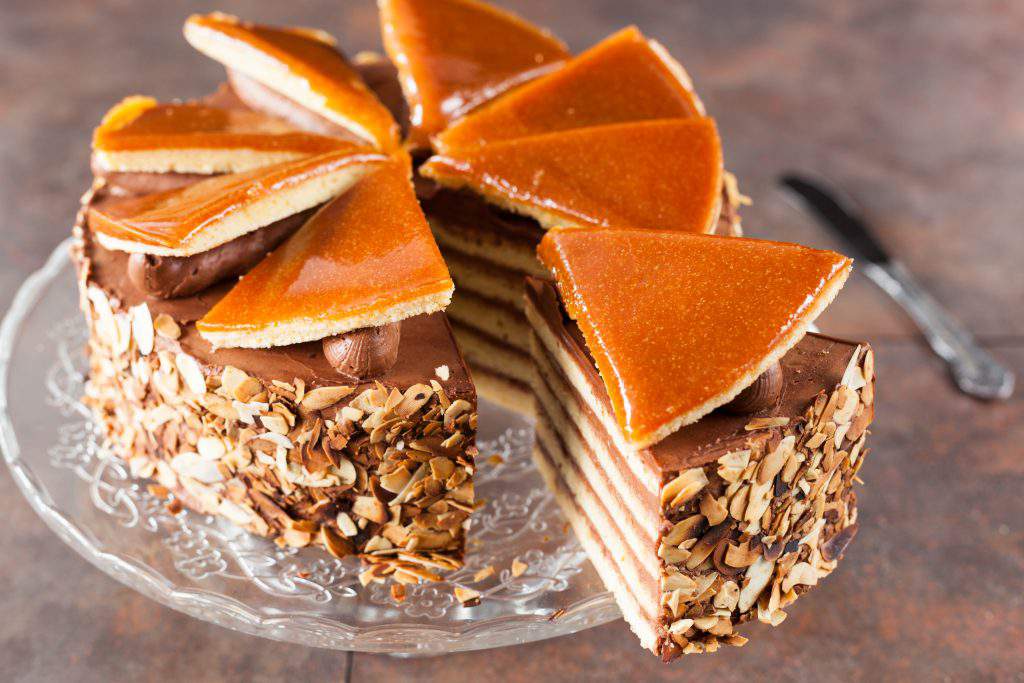
Hungarian Cuisine Beyond Paprika
The sophisticated, ‘everyday cuisine’ described by Gyula Krúdy, showed a different, far more complex, picture to the delicious, but red-paprika overdosed, repertoire of dishes considered ‘Hungarian’. After World War II. József Venesz, the emblematic figure of the catering industry during the Kádár regime, was generally associated with the origin of this now seemingly home-style cuisine. His textbook became the guide for generations of Hungarian chefs and many editions of his cookbook were published. Instead of the civic traditions of Hungarian cuisine, Venesz preferred peasant dishes and those that appeared to be such. Until the 1930s, the everyday favourites in Hungarian kitchens had rich seasoning with lots of green herbs or milder French seasoning, and many dishes with sour flavours reflecting Romanian and South Slav influences. The silky, sour soup made of freshwater crayfish, and hunter’s meat made with slow roasted dark brown root vegetables were also favourite meals.
If you would like to read more interesting articles on GLOBS Magazine, please click HERE
or you can buy online The GLOBS Magazine on DigitalStand
Source: by Anna Hajdu/GLOBS Magazine






Hungarian food is absolutely